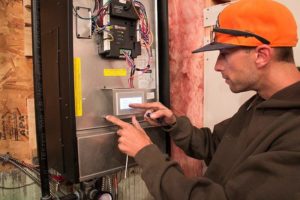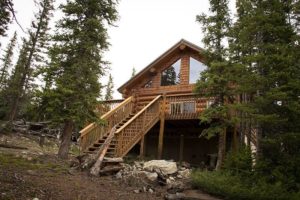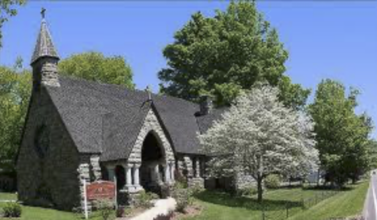High Altitude Boiler Bliss
By Dan Vastyan
Intro Photo: (L-R) Neil Wagner, Nick Valenti, Mike Merryman of McCoy Sales and Ben Dunn.
Just about anything that consumes a fuel source – whether that be a human body, an automobile, or a gas range – performs best at sea level. Oxygen levels in the atmosphere decrease exponentially as elevation increases. At 16,000 feet above sea level, a cubic foot of air contains about half the oxygen as a cubic foot at the beach.
To make matters more complicated for heating appliances, the lowered atmospheric pressure at high elevation means that LP and natural gas expand further, reducing their per-cubic-foot BTU content.
Boilers aren’t immune to the effects of high elevation. More often than not, proper installation of a gas boiler above 2,000 feet requires the burner’s orifice plate to be changed in order to de-rate the unit. This is usually at a rate of 4% per 1,000 feet of elevation. A technique that some techs call “fill and drill” can also be used in lieu of a replacement orifice jet. This involves filling an orifice with solder and carefully drilling it to the exact size needed with special orifice bits.
But thin air isn’t the only oddity that technicians in the mountain states face on a daily basis.
“Last week, one of our guys got to a service call and found a mountain lion on the porch,” said Nick Valenti, owner of IDS (Innovative Design Systems). Their location in central Colorado means they encounter plenty of wildlife, thin air and deep snow.
IDS was founded in 1974 and was purchased by Valenti this January. After ten years of commercial and residential experience throughout the state, he moved back home and bought the company he first started with. Today, he and two apprentices serve Park County and surrounding areas.
This past March, the company arrived in Fairplay, Colo. (elevation 9,953 ft.), to install a boiler for an existing radiant system in a log cabin. It came as no surprise that the sides of the driveway were piled eight feet deep with fresh powder.
The right appliance for the job
When homeowner Kyle Webb called IDS, he said they weren’t getting enough heat. Upon arrival, Valenti found a tank-type water heater being used to produce not only DHW, but also hot water for the home’s radiant system.
My wife and I built this house over the course of 18 months,” said Webb. “We had the water heater installed as a quick, temporary fix and left it in service a bit longer than planned. It kept the house from freezing, but we relied on the wood stove to make it comfortable, while for the water in the house we got a Water Damage Restoration Manalapan service to help us in case we have some water issues.
The beautiful 3,000-foot residence has in-slab heat on the ground floor and gypcrete over Uponor oxygen-barrier PEX upstairs (get straight stairlifts services from here). All the heat came through one small Triangle Tube brazed-plate heat exchanger on three-quarter-inch pipe. This meant that heat delivery to the home was limited to 40,000 BTUH at best, regardless of the water heater’s capacity or the total feet or radiant tubing. Zoning is accomplished with three remote Uponor brass compression manifolds and Honeywell zone valves.
After performing a heat load calculation, IDS suggested a condensing boiler, indirect tank and variable speed circulator. Their bid was soon accepted.
“We called four boiler manufacturers to see who’d stand behind their product at this elevation, and US Boiler Company was the only one. They suggested the K2 boiler. We had never installed a K2 before,” he continued. “Having installed Burnham Alpine boilers, we expected good things.”

Boiler evolution
By using oxygen more efficiently, the human body adapts to higher elevation in relatively short order. If you fly from NYC (13 ft. above sea level at JFK airport) to Aspen, CO (7,900), you might get winded walking up a short flight of steps. But you’re not nearly as likely to notice it after a few days in town.
The K2 performs in a similar manner. Proprietary technology and combustion components provide high altitude performance while maintaining proper operation at all elevations, and with little or no de-rate at high elevations.
Apprentices Ben Dunn and Neil Wagner helped Valenti remove the old LP-fired, State water heater and “near-water heater piping.” The new 100 MBH boiler was hung on the wall and the existing vent penetrations were re-used.
Named after the world’s second highest mountain, the K2 is available in five sizes from 80 to 180 MBH, offers up to 95 percent efficiency and is compatible with most types of vent terminations. The boiler and materials were supplied by Shawn Samuelson at Salida Winnelson.
IDS accounts for an average snow load of nine feet, so venting in the mountains can be tricky. At the job in Fairplay, the vent penetrations are nine feet above grade on the leeward side of the house, with two or three additional feet of pipe used above that.
In mountainous regions, temperature can rapidly fluctuate with sun exposure and changing pressure systems. This makes outdoor reset invaluable, especially when super-low design temps are needed. In town, IDS use a -7°F design temperature.
A single Taco ECM (electronically commutated motor) circulator was used for distribution to all manifolds. Using a variable-speed circulator allows IDS to run numerous zones off one pump, lowering upfront and operating costs. Taco manufactures two different residential-size ECM circulators.
The VT2218 is a Delta-T circulator, responding to the temperature differential between supply and return water. The VR1816 is a pressure-sensing model (Delta-P), with six pre-set modes. ECM motors are capable of cutting power consumption by up to 85 percent when compared to similar conventional motor.
Comfort, quickly
In and out in less than two days, IDS used Milwaukee’s M12 ProPEX expansion tool to speed up the installation. Aside from the boiler, Dunn, Valenti and Wagner were familiar with all the components they had selected. A Taco SR504 Zone Control was used, and they installed a Webstone primary/secondary loop purge tee. Despite trying a new boiler model, it wasn’t a snagging point.
“I was surprised by how light and compact the K2 is, but it doesn’t come at the expense of any room inside the cabinet,” said Valenti. “The touchscreen control walked us through setup very easily.” The job was done in early March, just in time for a few more cold snaps to demonstrate the effectiveness of the new system.
“We immediately noticed how much more responsive the radiant system is,” said Webb. “I’m also no longer concerned about the water heater leaking while we’re away. We made a great decision hiring IDS.”
Next winter, the Webbs are likely to see a reduction in propane consumption in addition to the major comfort improvement. And with folks in the High Rockies paying upwards of $3.00 per gallon, gas savings are welcome. The home has a 500-gallon above ground LP tank.
Since their first K2 application, IDS installed another one in the ski town of Breckenridge, which rests at 9,600 feet above sea level. This time, they didn’t need to look around for the right boiler.




I wouldn’t have thought elevation would affect the boiler that much. I also didn’t know that 16,000 feet had half the oxygen than at sea level. I live at about the 4,500 range, but I wonder if they make the boilers around here to accommodate more to the elevation? Interesting stuff, thanks for the info!